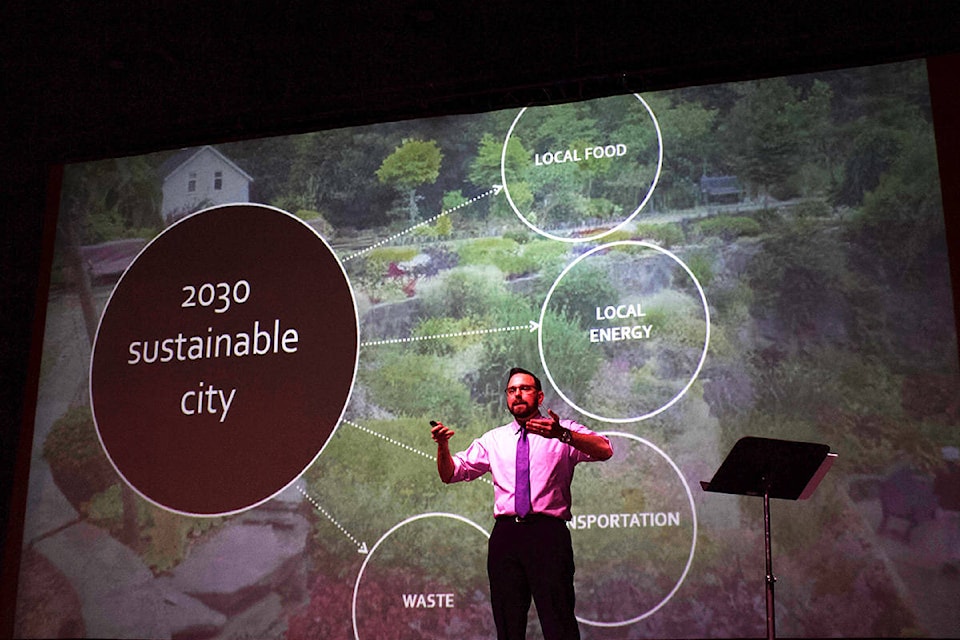Prince Rupert’s future is bright — but first, the city needs to draw more money from the port and fix its decaying infrastructure. That’s the message Mayor Lee Brain presented to residents last Wednesday. Dubbed Hays 2.0, it’s a vision for a vibrant, beautiful, globally connected city at the gateway to the Pacific.
But first, there’s more than $252 million in basic infrastructure repairs the city needs to deal with before 2020, including the construction of a new landfill, a waste water treatment plant, a $30-million RCMP building, and a city-wide upgrade to the water supply system. That’s without counting another $100 million in other repairs to fire hall, the city’s wooden bridges, and the airport ferry. In all, the city anticipates it will need to spend at least $350 million on basic infrastructure repairs in the next ten years.
It’s a hefty price tag for the city, and one Brain hopes to meet without raising taxes on residents of Prince Rupert.
“We have two huge revenue challenges that are essentially stopping us from moving forward. It’s why we havn’t been able to move forward since the mill closed down. These are the handcuffs that have been placed on this community, and its no fault of any previous council.”
The first challenge is a piece of provincial legislation — the Port Property Tax Act. Created in 2004, the legislation was meant to cap the municipal tax rate for export industries across the province. That prevented two neighbouring municipalities, such as Vancouver and North Vancouver, from having different tax rates, and encouraged companies to invest in B.C.’s ports. But at a capped rate, the tax municipalities can collect from the port decreases each year because of depreciation. That means that as the value decreases, the port ends up paying less and less municipal tax each year, despite significant growth in the port’s activity.
“Basically, residents have been forced to pay the bills, and city council hasn’t been able to get rid of this chain because it really isn’t council’s fault,” Brain said.
The second is the Ridley Island tax sharing agreement. Signed in 1981 but without a termination date, the agreement gives Port Edward 20 per cent of the municipal tax revenues generated from Ridley Island. That worked at the time, when the grain and coal terminals on Ridley Island were in their early stages and Prince Rupert was still benefiting from the pulp mill.
READ MORE: Tax sharing is one-sided, Brain
Since, the mill has closed Port Edward continues to receive 20 per cent of the capped port taxes despite repeated attempts by Prince Rupert to negotiate a better deal.
“So we have to pay for another town, and can’t collect the taxes off the industry here,” said Brain.
Dealing with those limitations on the city’s finances are at the top of Brain’s list of priorities. He’s working with the other seven port municipalities in B.C. in lobbying the provincial government to change the Port Property Tax Act, and he’s seeking new routes to break the city’s impasse with Port Edward over the Ridley Island tax sharing agreement.
He’s counting on the tax revenue generated by the AltaGas Ltd. project, due to come online next year at Ridley Island. The city has also secured a propane export facility on Watson Island with the Pembina Pipeline Corporation.
READ MORE: Pembina’s Watson Island plans unveiled at open house
With a larger, guaranteed revenue stream, Brain hopes the city will be able to effectively deal with its aging infrastructure and start developing into the future that includes creating more trails and bike lanes in the city; working with the provincial government, Metlakatla, Lax Kw’alaams, and Ketchikan, Alaska, to develop an efficient transportation system between the communities; and redeveloping the city’s waterfront.
But Brain was clear: for those visions of the city to become a reality, it will need to deal first with aging infrastructure and significant funding hurtles.
“It’s about piecing the vision together,” he said.
newsroom@thenorthernview.com
Like us on Facebook and follow us on Twitter
